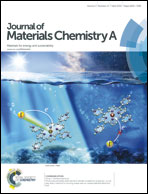A lithiation/delithiation mechanism of monodispersed MSn5 (M = Fe, Co and FeCo) nanospheres†
Abstract
A designed Sn based alloy host as a higher capacity and longer cycle life next generation lithium-ion battery, consisting of monodisperse nanospheres of intermetallic MSn5 (M = Fe, Co and FeCo) phases was synthesized by a nanocrystal conversion chemistry method using preformed Sn nanospheres as templates. The same crystal structure, identical particle surface morphology and the similar particle size distribution (30–50 nm) of these intermetallic MSn5 (M = Fe, Co and FeCo) phases are ideal for comparison of the electrochemical performance, reaction mechanism, thermodynamics and kinetics during lithiation/delithiation. Importantly, MSn5 (M = Fe, Co and FeCo) phases with defect structures Fe0.74Sn5, Co0.83Sn5 and Fe0.35Co0.35Sn5, exhibit the highest theoretical capacity of >917 mA h g−1 among the reported M–Sn (M is electro-chemically inactive) based intermetallic anodes. The ex situ XRD and XAFS illustrate the complete reversibility of MSn5 (M = Fe, Co and FeCo) phases during lithium insertion/extraction for the first cycle. The Fe0.35Co0.35Sn5 anode can take advantage of both high capacity of Fe0.74Sn5 and long cycle life of Co0.83Sn5, providing 736 mA h g−1 and maintaining 92.7% of initial capacity after 100 cycles with an average capacity loss of only 0.07% per cycle. The excellent electrochemical performance of the Fe0.5Co0.5Sn5 system is attributed to higher reversibility, lower reaction resistance. This work provides a novel insight toward designing and exploring an optimal Sn based alloy anode for next generation Li-ion batteries.


 Please wait while we load your content...
Please wait while we load your content...